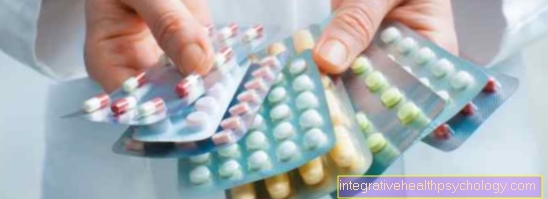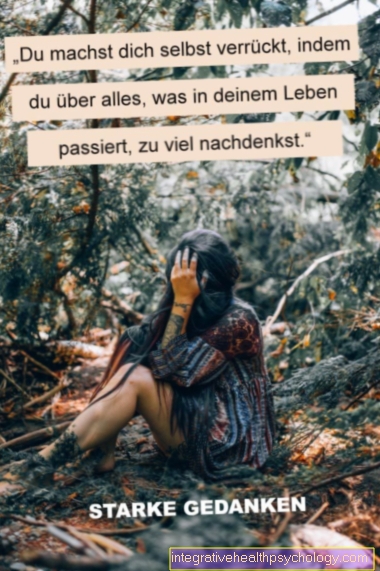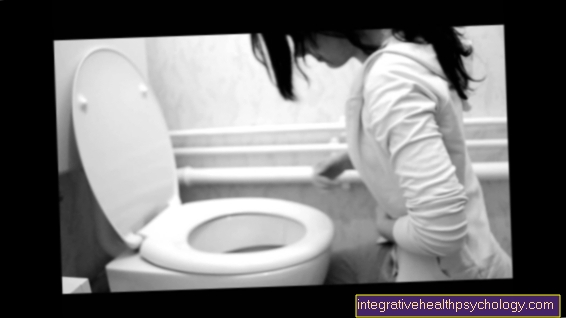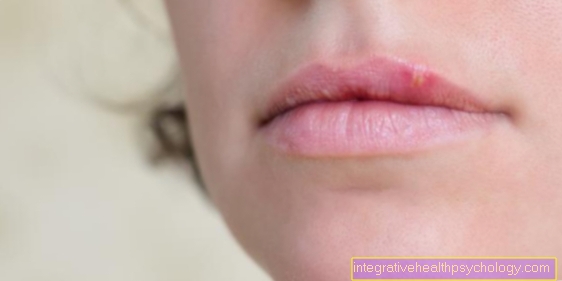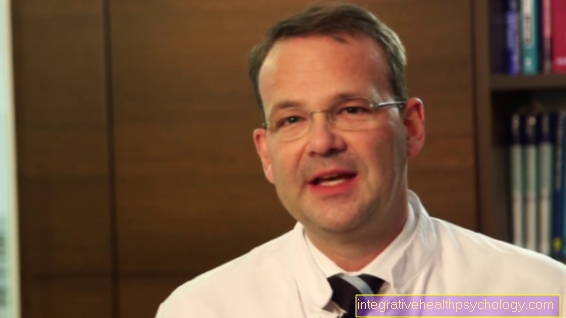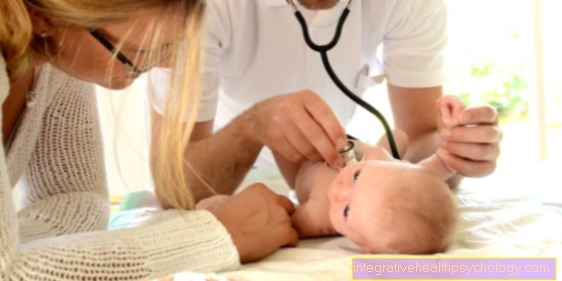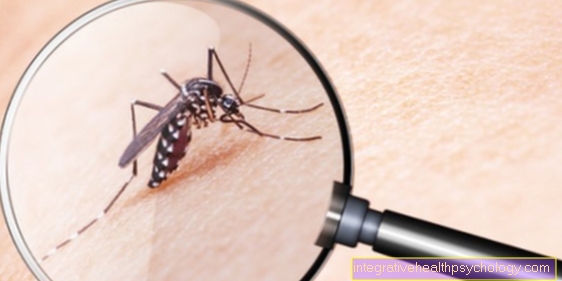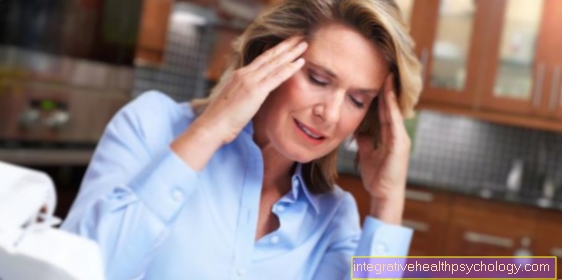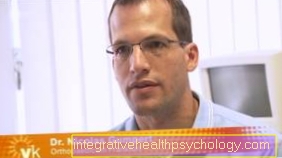Shingles on the neck
introduction
Shingles or medical herpes zoster is a viral disease that manifests itself in vesicular, painful rashes in a strictly limited area of the body. The cause is the varicella zoster virus (VZV). The varicella zoster virus belongs to the group of herpes viruses, i.e. those viruses that also Herpes labialis, so trigger the cold sore.

If you take a closer look at shingles, you will find similarities to cold sores, at least externally. The shingles got its name because of the belt-shaped appearance around the body. Sometimes the rashes are expressed in the form of a half-sided "ribbon", so they do not necessarily have to completely surround the body. A good third of a million people in Germany develop shingles every year. Two thirds of the sick are over 50 years old.
This shows the correlation between age and onset of the disease. While the immune system can successfully suppress an outbreak of the varicella virus in younger years, it is often too weak in old age to take effective countermeasures. In addition, a good 98% of the population becomes infected with the varicella zoster virus (VZV) up to the age of 40, so that a later outbreak is very likely. In patients over 85 years of age, the risk of developing shingles is even over 50%.
Cause of shingles
An outbreak of shingles is the result of a reactivation of the varicella viruses already in the body. Stress, immune deficiency and age are particularly responsible for a new outbreak.
Shingles is strictly limited to one area, for example the neck. This is because the viruses are in the Spinal ganglia fix in the spinal cord. A Spinal ganglion is a complex of nerve fibers that is located in pairs to the right and left of a vertebral body and arises from the spinal cord. The varicella viruses can now establish themselves in this spinal ganglion and go into hibernation, so to speak.
Normally they are kept in check by our immune system, but when this is otherwise busy, the varicella viruses, so to speak, sense their chance and are distributed along the nerve fibers of the spinal ganglion.
Since a spinal ganglion is always responsible for a precisely circumscribed area, shingles does not appear on the entire body, but only on a specific segment, for example the neck. In this way, one can directly trace back on the neck from which vertebral body segment the virus originated: namely segment C3 (vertebral body number 3).
The segment that is served by the spinal ganglion or vertebral body is also called the dermatome. A dermatome is like the projection of a vertebral body and its nerve fibers onto a specific area of skin. In shingles, the actual dermatome of the spinal ganglion is affected, as well as usually the one or two adjacent dermatoms. Only in the case of very severe immune insufficiency can a complete physical attack occur.
Read more on this topic at: Causes of Shingles
Symptoms
The symptoms of shingles are fairly typical. At first the patient experiences a slight feeling of illness, with headache, aching limbs and a slight fever. Neck stiffness can also occur in some cases.
As a result, pain occurs in the supply area (dermatome) of the spinal ganglion. There is pulling, stabbing, and sometimes dull pain. It is rather rare for this phase to go through without pain, but it can also be the case.
There is a smooth transition to the subsequent phase, in which tingling and abnormal sensations in the corresponding skin segment dominate the symptoms. These are sometimes described by patients as pain, sometimes as tingling.
How severe the pain is varies from person to person and also depends on the severity of the infection. In some cases, however, the pain can be extremely severe, which makes therapy with painkillers absolutely necessary.
In any case, typical, small vesicles that are about the size of a pinhead will form. They are shaped like grains of rice and sit on top of the reddish rash. Real fields of these vesicles are formed, which are arranged in associations and are in turn strictly limited to the affected skin segment. This can be particularly annoying on the neck, as textiles such as shirt collars, scarfs or ties rub especially against the rash.
Read more on this topic at: Course of shingles
Shingles pain
Shingles on the neck often cause very severe pain. The varicella zoster virus specifically attacks the nerves. This nerve pain is felt to be particularly excruciating. It is therefore important to take high doses of painkillers. In addition to classic painkillers, special nerve painkillers (e.g. drugs such as antidepressants) can also be used. Unfortunately, without adequate pain therapy, it happens relatively often that the pain persists even after the disease has healed. One then speaks of one Post-zoster neuralgia. These are nerve pains that occur after the actual shingles (Herpes zoster) occur.
Additional information can be found here: Shingles pain
Is there shingles on the neck without pain?
Most of the time, shingles is a very painful condition. Those affected often have to take very strong painkillers so that the pain does not become chronic. Unfortunately, this danger always exists, especially with nerve pain.
Of course, it can also be possible that shingles starts with relatively little pain in the early stages. If you discover the blister-like changes on the skin early and treat them quickly and consistently, then it is quite possible that the shingles in this case will proceed largely without pain. Such a course is rather unusual.
Shingles itching
The typical rash in shingles consists of small fluid-filled blisters. These affected skin areas itch terribly. However, it is important not to scratch despite the itching. This allows the vesicles to open before they become encrusted and the highly infectious contents can escape and a second infection with the virus can occur in another part of the body. In addition, scratching often leads to scars. To relieve the itching, special ointments or creams can be applied to the pustules.
Read more on this topic at: Shingles medication
Swollen lymph nodes on the neck
The lymphatic system protects the body from pathogens. Therefore, shingles of the neck can also lead to swelling of the cervical lymph nodes. The varicella zoster virus is responsible for this. It attaches itself to the Ganglia (= Accumulation of nerve cell bodies) and leads to inflammation of the corresponding nerve and the skin region that is sensitively supplied by it.
Along with this characteristic rash, swollen cervical lymph nodes are a classic sign of shingles. Of course, swelling of the lymph nodes in the neck can also have many other causes.
Additional information can be found here: Lymph node swelling in the neck
Treatment of shingles on the neck
Shingles is usually self-limiting, which means it heals on its own. However, this can take a few days. Treatment during this time is only necessary in the case of severe pain.These are then treated with freely available, non-opioid pain relievers such as ibuprofen or paracetamol. Opioids would only be used if the pain is very severe.
It is also important to prevent the shingles from spreading from the neck to other segments. A generalization of shingles would primarily be associated with the same symptoms, but ultimately lead to a significant weakening of the immune system and the associated complications (more on this under “Complications”).
Read more on the topic: Course of shingles
The treatment is based on two pillars: On the one hand, the treatment of the skin changes, i.e. the redness and the blisters.
On the other hand, the treatment of the disease itself.
The former is treated with cooling compresses or ointments. Treatment also depends on the stage of the disease. While cooling is usually prescribed in the case of blistering, a zinc ointment lotion is more useful if healing has already started.
Antiviral therapy is carried out by administering antivirals. Antivirals are certain drugs that prevent the spread of viruses and fight viruses (please refer: Anti-virus drugs). Antivirals do not necessarily have to be taken because, as already mentioned, the shingles heals on its own after a few days. However, they accelerate healing and in certain cases may be necessary to prevent further spread of the shingles from the neck to other parts of the body.
Risk factors for such a spread include poor immune status, age over 50, simultaneous corticosteroid treatment, particularly severe forms on the trunk or general shingles in the head and neck area.
Shingles of the neck per se suggests treatment with antivirals - regardless of age, while mild shingles of the leg in young patients can also be treated without antivirals.
Typical antivirals in this case are: acyclovir, valaciclovir, and birvudin. Similar to antibiotics, the medication must be taken for a period of at least seven days. In immunosuppressed patients, however, it may be necessary to schedule a longer treatment period. After all, these are particularly at risk.
Some of these drugs are also used to treat head shingles.
Read more on this topic at: Shingles on the head - you should definitely pay attention to this!
In exceptional cases, immunoglobulins and interferons can also be taken in addition to antivirals. These "biologicals" usually have very few side effects, as they are almost identical to the body's own proteins and enzymes. They have to be produced artificially and very laboriously using biotechnological processes and are therefore often very expensive. However, they represent a growing business area in the pharmaceutical industry and are often referred to as the next generation of drugs.
You can also find more information about treating shingles in our article Shingles medication
How dangerous can shingles on the neck be?
Shingles on the head - what you should be aware of Shingles is a viral disease. An infection with the Varicella zoster virus triggers the disease.
The disease is particularly dangerous for older people. In principle, the disease can occur anywhere on the body, but in most cases only on one side of the body.
Shingles can also develop on the neck. Complications are always superinfections. Bacteria can settle on the injured skin.
Furthermore, the special spatial proximity to the face must be observed. The virus can affect the facial nerves or the eye. This can lead to serious consequences for the patient. Therefore, shingles on the neck should be treated as soon as possible.
Read more on this topic at: Shingles on the head - you should pay attention to this
Is shingles contagious?
Even if shingles may look very contagious, it is only under certain conditions: First of all, a good 98% of the population already carry the shingles virus (varicella virus). By the age of 40, it is precisely this percentage that has already become acquainted with the virus - in the form of chickenpox. Anyone who has had chickenpox in their youth or is vaccinated against chickenpox has nothing to fear, because they are already infected with the virus. Chickenpox, however, is highly contagious and is transmitted through the air. Since a chickenpox infection is far less severe in adolescence than in adulthood, it used to be customary to bring uninfected children into contact with children who are just going through a chickenpox infection, so that the uninfected child can also be infected.
You might also be interested in this: Zostavax® vaccination against shingles
What sounds relatively barbaric nowadays, had the advantage that both children got through the chickenpox infection and couldn't come back - because you can only get chickenpox once in your life. While chickenpox spreads through the air in the form of droplet infections, shingles is far less contagious. Only the content of the rice-grain-sized vesicles is contagious - but only for people who have never had a chickenpox infection. The background is that both chickenpox and shingles are triggered by the varicella vrius.
But why don't we all have shingles on our bodies all the time when 98% of people already carry the virus? This is because our immune system can normally suppress the viruses with ease. It is only when our immune system is exposed to severe stress that the varicella viruses sense their chance and spread, causing shingles to occur. Stress on our immune system arises from stress, immunosuppressive therapy, colds, or after transplants. Shingles only really breaks out in these cases. In addition, if one does not carry the virus in one's body, one would first have to come into direct contact with the contents of the vesicles of a sick person. In summary, the risk of infection is very low.
Read more on the topic: Is shingles contagious?
Shingles on the neck in children
With children the infection with shingles often runs much more harmlessthan in adults. Take their effects - as with the chickenpox - only with increasing age. In this respect, anyone who already has an infection can consider themselves lucky in childhood going through. While chickenpox is a typical childhood disease, shingles usually occurs first in old age on. Shingles infection is common to children under 10 years relative atypical. The symptoms are roughly the same as in adults: after a short period of using fever, and Headache, it then comes to an outbreak with training of glassy vesicles, and one relatively clear limited, reddish rash.
Shingles usually manifests itself in children under 10 years of age in the chest area, only with increasing age are areas like neck and head affected. The child's immune system is until the 10th age not fully developed, it is still learning during this time. It can therefore happen that the child's organism does not cope with the infection as well as that of an adult. If the shingles also occurs in the Head area on, it can become a Involvement of the eyes, and of the brain come. Also in view of the fact that shingles are rather rare in children, a pediatric clarification is then required at the latest.

